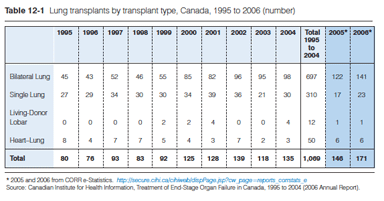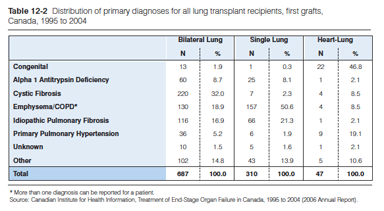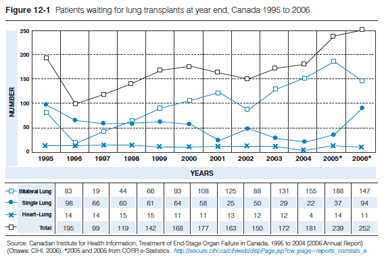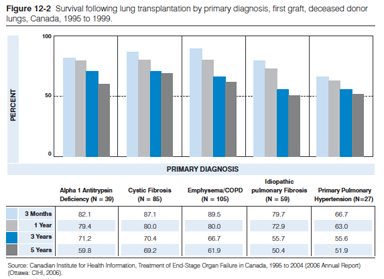Lung Transplantation
Introduction
Despite recent medical innovations to alleviate advanced pulmonary conditions, chronic lung diseases continue to result in significant premature mortality in Canada. Moreover, advanced lung disease imposes an enormous burden on Canadians, in quality of life as well as in economic costs for patients, caregivers and society.
Lung transplantation has become an important treatment option for some people with cardiorespiratory diseases. Worldwide over 20,000 single-lung, double-lung and combined heart–lung transplants have been performed in the past 25 years, and approximately 1,400 new transplants are performed annually.1
To date, the vast majority of donor lungs have come from deceased donors rather than from living donors. However, deceased donor organ transplantation is constrained by limited supply, in contrast to many advanced medical therapies, which may be limited by economic constraints.
Not all patients with advanced respiratory diseases are candidates for lung transplantation. In order to maximize the potential benefit from the limited donor resources, prospective recipients are evaluated in terms of established criteria that portend a favourable outcome. Broadly speaking, lung transplantation is ideally suited to younger patients with advanced lung disease who have no other therapeutic options. They should have limited prognosis for survival without transplantation (one to two years) and should not have other medical conditions that could unduly limit the success of the transplant or otherwise result in limited survival. Ultimately, each transplant program makes decisions about individual candidates on a case-by-case basis, since even many “non-ideal” patients may derive significant benefit, both in terms of quality and length of life.
The number of people waiting for any kind of lung transplant has more than doubled in the past 10 years. The number of patients on waiting lists for bilateral lung transplantation in Canada has gradually increased over the past decade (Figure 12-1).
Transplant Volumes
The number of lung transplants performed in Canada has steadily increased to 171 in 2006 (Table 12-1). The majority of lung transplants have been performed for emphysema/alpha-1 antitrypsin deficiency, cystic fibrosis and pulmonary fibrosis (Table 12-2). There are five active lung transplant centres in Canada, in Montreal, Toronto, Winnipeg, Edmonton and Vancouver.
Lung transplants are carried out much less frequently than other deceased donor solid organ transplants, less than one third as often as renal and liver transplants, for example. This relates largely to the vulnerability of the lungs to infection or other dysfunction in critically ill potential donors before they are declared brain dead. In the 2004 global experience, one or both lungs were suitable for transplantation in only 28.3% of all deceased donors.2 A number of important factors affect deceased donor organ donation rates including sociocultural attitudes, public education and promotion, and mortality rates for otherwise healthy younger individuals from causes likely to permit organ donation (e.g., head trauma, intracranial hemorrhage).
Health Outcomes Following Lung Transplantation
In the 25 years since lung transplantation became clinically feasible, advances in areas such as donor–recipient selection, operative technique, postoperative care, immunosuppression regimens and anti-infective prophylactic strategies have resulted in substantial improvements in recipient outcomes. Anticipated survival rates following lung transplantation are approximately 80% at one year and 60% at 5 years.3 Half of double-lung recipients are expected to survive for 5.6 years, and half of single-lung recipients can expect to survive for 4.3 years.4 The most important factors associated with mortality in the first 30 days following transplant include primary graft dysfunction, infections and technical problems related to the peri-operative period.5 The most important factors resulting in late mortality after a transplant include bronchiolitis obliterans, infections, cancer and cardiovascular disease.6
Hypertension, dyslipidemia and diabetes are commonly observed in individuals who have received lung transplants. In addition, nearly 50% of lung transplant recipients have evidence of bronchiolitis obliterans syndrome (chronic rejection) at five years.7 Mild-to-moderate renal dysfunction is common, and up to 7% of lung transplant recipients require renal dialysis or renal transplant within seven years following transplant.8 It is also becoming apparent that, as with other solid organ transplants, chronic immunosuppression is associated with a high incidence of neoplasms, predominantly skin cancers and lymphomas.9
Despite the successes achieved to date in clinical lung transplantation, long-term outcomes remain suboptimal. The major intermediate to long-term complication of lung transplantation resulting in morbidity and mortality is bronchiolitis obliterans (BO). Clinically, BO presents as chronic progressive allograft dysfunction with airflow limitation as a result of small airways obstruction, thought to be a manifestation of chronic rejection. While uncommon in the first year following transplant, BO incidence increases steadily thereafter. It is present in at least half of long-term lung transplant survivors and is the predominant cause of death after the first year following transplant.
Besides achieving a survival advantage, lung transplant recipients realize substantial improvements in functional capacity and health-related quality of life.10 More than 80% of lung transplant recipients surviving more than five years report no activity limitations, and approximately 40% return to the workforce.11 Self ratings for health-related quality of life have been reported to be highly dependent on the incidence of infections, rejection episodes and the onset of BO syndrome.12
Health Care Costs
A report commissioned by the British Columbia Transplant Society in 2000 estimated initial inpatient costs in the range of CAN$63,000 for lung transplantation, based on length of stays averaging 26 days (range 13-88 days).13 This estimate included expenses for nursing units, operating rooms, pharmacy, diagnostic imaging, clinical laboratory services, and allied health and support services. More recent estimates place costs for the initial hospitalization for lung transplantation in the range of CAN$100,000–$150,000.14 However, monthly costs for care decrease from before to after the transplant actually decrease15 unless complications develop.
The majority of care following lung transplantation is provided in ambulatory mutlidisciplinary transplant clinics. In the first year following lung transplantation, approximately 50% of lung transplant recipients require re-hospitalization for treatment of rejection, and 10% for other reasons.16
Discussion and Implications
There have been slow but steady increases in the number of lung transplants being performed in Canada. Applicants for lung transplants must often deal with strict criteria because the supply is inadequate. An increase in the number of donor organs might make it possible for these criteria to be applied with less stringency. Recent developments could enlarge the donor pool. These include lobar donation from living donors, donation after cardiocirculatory death17 and, in the longer term, donor organs from other species (xenotransplantation).
1 Trulock EP, Edwards LB, Taylor DO, Boucek MM, Keck BM, Hertz MI. Registry of the International Society for Heart and Lung Transplantation: Twenty-thrd Official Adult Lung and Heart-Lung Transplant Report—2006. J Heart Lung Transplant. 2006;25:80-892. Available from: http://www.ishlt.org/contentDocuments/lung_adult.ppt
2 Orens JB, Estenne M, Arcasoy S, Conte JV, Corris P, Egan JJ, Egan T, Keshavjee S, Knoop C, Kotloff R, Martinez FJ, Nathan S, Palmer S, Patterson A, Singer L, Snell G, Studer S, Vachiery JL, Glanville AR. International Guidelines for the Selection of Lung Transplant Candidates: 2006 Update—A Consensus Report From the Pulmonary Scientific Council of the International Society for Heart and Lung Transplantation. J Heart Lung Transplant. 2006 Jul; 25: 745-755.
10 Kugler C, Fischer S, Gottlieb J, Welte T, Simon A, Haverich A, Strueber M. Health-Related Quality of Life in Two Hundred-Eighty Lung Transplant Recipients. The Journal of Heart and Lung Transplantation, Volume 24, Issue 12, Pages 2262-2268.
13 Kurueger H et al. Inc. Solid organ transplant initial inpatient costs. August 4, 2000.
14 Based on figures supplied informally by BC Transplant and by the Canadian Lung Transplant Study Group (in its meeting at Banff, Alberta, March 2007).
15 Sharples LD, Taylor GJ, Karnon J, Caine N, Buxton M, McNeil K, Wallwork J. A model for analyzing the cost of the main clinical events after lung transplantation. J Heart Lung Transplant 2001;20:474-482.
17 Shemie SD, Kn, Ro H Dn J, iarello J, ers-Evans J, ld S, GW, W, D, S, ck B, Do National recommendations for donation after cardiocirculatory death in Canada: Donation after cardiocirculatory death in Canada. CMAJ 2006;175:S1.




